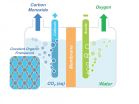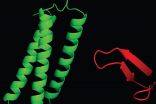(Press-News.org) Washington, DC--People who developed Type 2 diabetes tended to take more antibiotics in the years leading up to the diagnosis than people who did not have the condition, according to a new study published in the Endocrine Society's Journal of Clinical Endocrinology & Metabolism.
A person develops diabetes, which is characterized by high blood sugar levels, when the individual cannot produce enough of the hormone insulin or insulin does not work properly to clear sugar from the bloodstream.
More than 29 million Americans have diabetes, according to the Society's Endocrine Facts and Figures report. Type 2 diabetes, the most common form of the condition, accounts for 90 to 95 percent of all cases.
"In our research, we found people who have Type 2 diabetes used significantly more antibiotics up to 15 years prior to diagnosis compared to healthy controls," said one of the study's authors, Kristian Hallundbæk Mikkelsen, MD, of Gentofte Hospital in Hellerup, Denmark. "Although we cannot infer causality from this study, the findings raise the possibility that antibiotics could raise the risk of Type 2 diabetes. Another equally compelling explanation may be that people develop Type 2 diabetes over the course of years and face a greater risk of infection during that time."
As part of the population-based case-control study, researchers tracked antibiotic prescriptions for 170,504 people who had Type 2 diabetes and for 1.3 million people who did not have diabetes. The researchers identified the subjects using records from three national health registries in Denmark.
People who had Type 2 diabetes filled 0.8 prescriptions a year, on average. The rate was only 0.5 prescriptions a year among the study's control subjects. Individuals who filled more prescriptions were more likely to be diagnosed with Type 2 diabetes. Many types of antibiotics were associated with a higher risk of diabetes, but there was a stronger link with the use of narrow-spectrum antibiotics such as penicillin V.
Past research has shown that antibiotic treatments can alter the bacteria in an individual's gut. Studies suggest certain gut bacteria may contribute to the impaired ability to metabolize sugar seen in people with diabetes. This may explain why higher rates of antibiotic use are associated with the development of Type 2 diabetes, but more research is needed to explain the findings, Mikkelsen said.
"Diabetes is one of the greatest challenges facing modern health care, with a globally increasing incidence" he said. "Further investigation into long-term effect of antibiotic use on sugar metabolism and gut bacteria composition could reveal valuable answers about how to address this public health crisis. Patterns in antibiotic use may offer an opportunity to prevent the development of the disease or to diagnose it early."
INFORMATION:
Other authors of the study include: Filip K. Knop of the University of Copenhagen; and Morten Frost, Jesper Hallas and Anton Pottegård of the University of Southern Denmark in Odense, Denmark.
The study, "Use of Antibiotics and Risk of Type 2 Diabetes: A Population-based Case-control Study," was published online at http://press.endocrine.org/doi/10.1210/jc.2015-2696, ahead of print.
Founded in 1916, the Endocrine Society is the world's oldest, largest and most active organization devoted to research on hormones and the clinical practice of endocrinology. Today, the Endocrine Society's membership consists of over 18,000 scientists, physicians, educators, nurses and students in 122 countries. Society members represent all basic, applied and clinical interests in endocrinology. The Endocrine Society is based in Washington, DC. To learn more about the Society and the field of endocrinology, visit our site at http://www.endocrine.org. Follow us on Twitter at https://twitter.com/#!/EndoMedia.
Washington, DC--Taking 3-minute breaks to walk in the middle of a TV marathon or other sedentary activity can improve children's blood sugar compared to continuously sitting, according to a new National Institutes of Health (NIH) study published in the Endocrine Society's Journal of Clinical Endocrinology & Metabolism (JCEM).
A sedentary lifestyle can put children at risk of developing pediatric obesity and metabolic health problems such as diabetes. Nearly 17 percent of children and teens nationwide are obese, according to the Society's Endocrine Facts and Figures report. ...
Washington, DC--For years after it was administered, growth hormone continued to reduce the risk of fractures and helped maintain bone density in postmenopausal women who had osteoporosis, according to a new study published in the Endocrine Society's Journal of Clinical Endocrinology & Metabolism.
Osteoporosis is a progressive condition that causes the bones to become weak and more likely to break. More than 10 million American adults have osteoporosis, and 80 percent of the people being treated for the condition nationwide are women, according to the Society's Endocrine ...
NASA's Aqua satellite and NOAA's GOES-West satellite provided temperature and cloud data on newborn Tropical Storm Jimena in the Eastern Pacific Ocean. Data from both satellites show the storm continues to consolidate.
Tropical Depression 13E formed about 865 miles (1,390 km) south-southwest of the southern tip of Baja California, Mexico at 5 p.m. EDT (2100 UTC) on August 26. Six hours later, the depression strengthened into Tropical Storm Jimena at 11 p.m. EDT.
A false-colored infrared image from Aug. 27 at 09:47 UTC (4:57 a.m. EDT) showed high, cold, strong thunderstorms ...
A molecular system that holds great promise for the capture and storage of carbon dioxide has been modified so that it now also holds great promise as a catalyst for converting captured carbon dioxide into valuable chemical products. Researchers with the U.S. Department of Energy (DOE)'s Lawrence Berkeley National Laboratory (Berkeley Lab) have incorporated molecules of carbon dioxide reduction catalysts into the sponge-like crystals of covalent organic frameworks (COFs). This creates a molecular system that not only absorbs carbon dioxide, but also selectively reduces ...
Researchers reporting in the Cell Press journal Current Biology on August 27 have evidence in support of a clearly defined depth limit for deep-sea fishing in Europe. The findings come just as the European Union considers controversial new legislation to manage deep-sea fisheries, including a ban on trawling below 600 meters.
"The most notable thing to consider about our findings is that the trend in catch composition over the depth range of 600 to 800 meters shows that collateral ecological impacts are significantly increasing while the commercial gain per unit effort ...
Isaac Newton was a classic neurotic. He was a brooder and a worrier, prone to dwelling on the scientific problems before him as well as his childhood sins. But Newton also had creative breakthroughs--thoughts on physics so profound that they are still part of a standard science education.
In a Trends in Cognitive Sciences Opinion paper published August 27, psychologists present a new theory for why neurotic unhappiness and creativity go hand-in-hand. The authors argue that the part of the brain responsible for self-generated thought is highly active in neuroticism, which ...
Researchers at the Virginia Bioinformatics Institute at Virginia Tech have uncovered key cellular functions that help regulate inflammation -- a discovery that could have important implications for the treatment of allergies, heart disease, and certain forms of cancer.
The discovery, to be published in the Oct. 6 issue of the journal Structure, explains how two particular proteins, Tollip and Tom1, work together to contribute to the turnover of cell-surface receptor proteins that trigger inflammation.
"The inflammatory response can be a double-edged sword," said Daniel ...
Mobility between different physical environments in the cell nucleus regulates the daily oscillations in the activity of genes that are controlled by the internal biological clock, according to a study that is published in the journal Molecular Cell. Eventually, these findings may lead to novel therapeutic strategies for the treatment of diseases linked with disrupted circadian rhythm.
So called clock-controlled - or circadian - genes are part of the internal biological clock, allowing humans and other light-sensitive organisms to adjust their daily activity to the cycle ...
Cold Spring Harbor, NY - When a large combat unit, widely dispersed in dense jungle, goes to battle, no single soldier knows precisely how his actions are affecting the unit's success or failure. But in modern armies, every soldier is connected via an audio link that can instantly receive broadcasts - reporting both positive and negative surprises - based on new intelligence. The real-time broadcasts enable dispersed troops to learn from these reports and can be critical since no solider has an overview of the entire unit's situation.
Similarly, as neuroscientists at Cold ...
LA JOLLA--Every organism--from a seedling to a president--must protect its DNA at all costs, but precisely how a cell distinguishes between damage to its own DNA and the foreign DNA of an invading virus has remained a mystery.
Now, scientists at the Salk Institute have discovered critical details of how a cell's response system tells the difference between these two perpetual threats. The discovery could help in the development of new cancer-selective viral therapies and may help explain why aging and certain diseases seem to open the door to viral infections.
"Our ...






